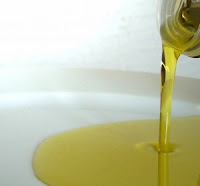Palm Oil | agriculture commodities - commodity prices - food sciences | Palm oil, coconut oil and palm kernel oil are edible plant oils derived from the fruits of palm trees. Palm oil is extracted from the pulp of the fruit of the oil palm Elaeis guineensis; palm kernel oil is derived from the kernel (seed) of the oil palm and coconut oil is derived from the kernel of the coconut (Cocos nucifera). Palm oil is naturally reddish in color because it contains a high amount of beta-carotene.
Palm oil, palm kernel oil and coconut oil are three of the few highly saturated vegetable fats. Palm oil is semi-solid at room temperatures. Palm oil contains several saturated and unsaturated fats in the forms of glyceryl laurate (0.1%, saturated), myristate (0.1%, saturated), palmitate (44%, saturated), stearate (5%, saturated), oleate (39%, monounsaturated), linoleate (10%, polyunsaturated), and linolenate (0.3%, polyunsaturated). Palm kernel oil and coconut oil are more highly saturated than palm oil. Like all vegetable oils, palm oil does not contain cholesterol (found in unrefined animal fats), although saturated fat intake increases both LDL and HDL cholesterol.
Palm oil is a common cooking ingredient in southeast Asia and the tropical belt of Africa. Its increasing use in the commercial food industry in other parts of the world is buoyed by its lower cost and the high oxidative stability (saturation) of the refined product when used for frying.
History of Palm Oil
Palm oil (from the African oil palm, Elaeis guineensis) has long been recognized in West African countries, and is widely used as a cooking oil. European merchants trading with West Africa occasionally purchased palm oil for use in Europe, but since the oil was of a lower quality than olive oil, palm oil remained rare outside West Africa. In the Asante Confederacy, state-owned slaves built large plantations of oil palm trees, while in the neighbouring Kingdom of Dahomey, King Ghezo passed a law in 1856 forbidding his subjects from cutting down oil palms.
Palm oil became a highly sought-after commodity by British traders, for use as an industrial lubricant for machinery during Britain's Industrial Revolution. Palm oil formed the basis of soap products, such as Lever Brothers' (now Unilever) "Sunlight Soap", and the American Palmolive brand. By c. 1870, palm oil constituted the primary export of some West African countries such as Ghana and Nigeria, although this was overtaken by cocoa in the 1880s.
Research on Palm Oil
In the 1960s, research and development (R&D) in oil palm breeding began to expand after Malaysia's Department of Agriculture established an exchange program with West African economies and four private plantations formed the Oil Palm Genetics Laboratory. The government also established Kolej Serdang, which became the Universiti Pertanian Malaysia (UPM) in the 1970s to train agricultural and agro-industrial engineers and agro-business graduates to conduct research in the field.
In 1979, following strong lobbying from oil palm planters and support from the Malaysian Agricultural Research and Development Institute (MARDI) and UPM, the government set up the Palm Oil Research Institute of Malaysia (Porim). B.C. Sekhar was instrumental in helping Porim recruit and train scientists to undertake R&D in oil palm tree breeding, palm oil nutrition and potential oleochemical use. Sekhar, as founder and chairman, pushed Porim to be a public-and-private-coordinated institution. As a result, Porim (renamed Malaysian Palm Oil Board in 2000) became Malaysia's top research entity commercializing 20% of its innovations, compared to 5% among local universities. While MPOB has gained international prominence, its relevance is dependent on churning out breakthrough findings in the dynamic oil crop genetics, dietary fat nutrition and process engineering landscapes.
Nutrition Content of Palm Oil
Many processed foods contain palm oil as an ingredient. Palm oil is composed of fatty acids, esterified with glycerol just like any ordinary fat. It is high in saturated fatty acids. Palm oil gives its name to the 16-carbon saturated fatty acid palmitic acid. Monounsaturated oleic acid is also a constituent of palm oil. Unrefined palm oil is a large natural source of tocotrienol, part of the vitamin E family.
The approximate concentration of fatty acids (FAs) in palm oil is as follows:
 |
red: Saturated; orange: Mono unsaturated; blue: Poly unsaturat |
@ agriculture commodities


No comments:
Post a Comment